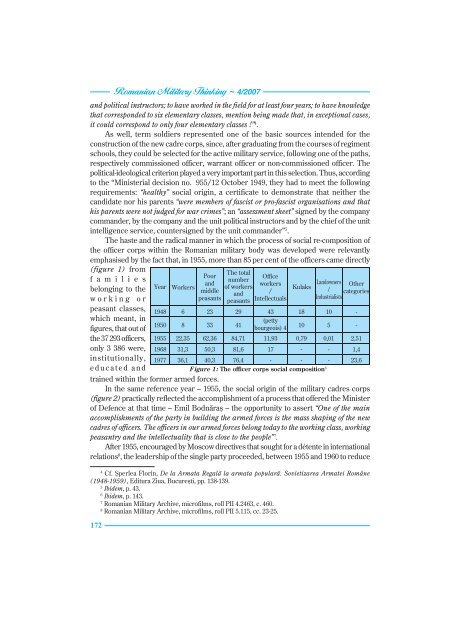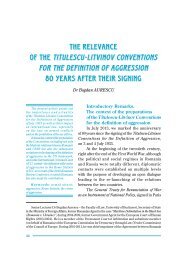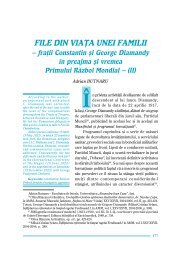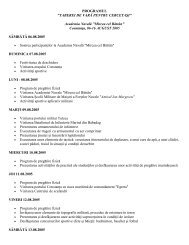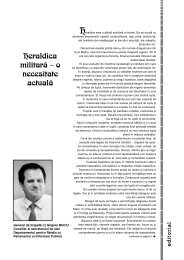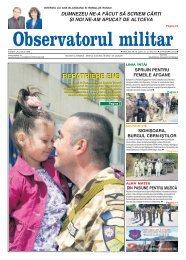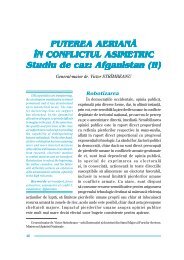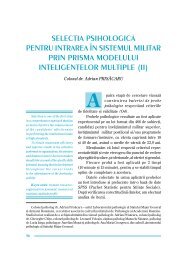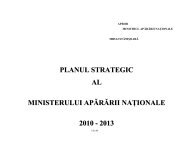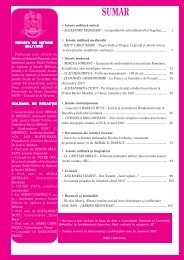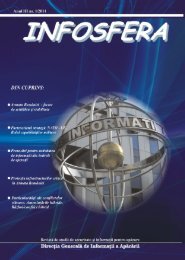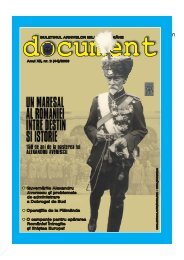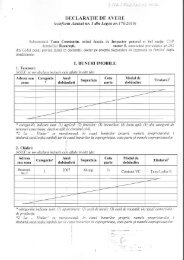Romanian Military Thinking
Romanian Military Thinking
Romanian Military Thinking
You also want an ePaper? Increase the reach of your titles
YUMPU automatically turns print PDFs into web optimized ePapers that Google loves.
172<br />
<strong>Romanian</strong> <strong>Military</strong> <strong>Thinking</strong> ~ 4/2007<br />
and political instructors; to have worked in the field for at least four years; to have knowledge<br />
that corresponded to six elementary classes, mention being made that, in exceptional cases,<br />
it could correspond to only four elementary classes !” 4 .<br />
As well, term soldiers represented one of the basic sources intended for the<br />
construction of the new cadre corps, since, after graduating from the courses of regiment<br />
schools, they could be selected for the active military service, following one of the paths,<br />
respectively commissioned officer, warrant officer or non-commissioned officer. The<br />
political-ideological criterion played a very important part in this selection. Thus, according<br />
to the “Ministerial decision no. 955/12 October 1949, they had to meet the following<br />
requirements: “healthy” social origin, a certificate to demonstrate that neither the<br />
candidate nor his parents “were members of fascist or pro-fascist organisations and that<br />
his parents were not judged for war crimes”; an “assessment sheet” signed by the company<br />
commander, by the company and the unit political instructors and by the chief of the unit<br />
intelligence service, countersigned by the unit commander” 5 .<br />
The haste and the radical manner in which the process of social re-composition of<br />
the officer corps within the <strong>Romanian</strong> military body was developed were relevantly<br />
emphasised by the fact that, in 1955, more than 85 per cent of the officers came directly<br />
(figure 1) from<br />
f a m i l i e s<br />
belonging to the<br />
working or<br />
peasant classes,<br />
which meant, in<br />
figures, that out of<br />
the 37 293 officers,<br />
only 3 386 were,<br />
institutionally,<br />
educated and<br />
Year Workers<br />
Poor<br />
and<br />
middle<br />
peasants<br />
The total<br />
number<br />
of workers<br />
and<br />
peasants<br />
Office<br />
workers<br />
/<br />
Intellectuals<br />
Kulaks<br />
Landowners Other<br />
/ categories<br />
Industrialists<br />
1948 6 23 29 43 18 10 -<br />
1950 8 33 41<br />
(petty<br />
bourgeois) 4<br />
10 5 -<br />
1955 22,35 62,36 84,71 11,93 0,79 0,01 2,51<br />
1968 31,3 50,3 81,6 17 - - 1,4<br />
1977 36,1 40,3 76,4 - - - 23,6<br />
Figure 1: The officer corps social composition6 trained within the former armed forces.<br />
In the same reference year – 1955, the social origin of the military cadres corps<br />
(figure 2) practically reflected the accomplishment of a process that offered the Minister<br />
of Defence at that time – Emil Bodn`ra[ – the opportunity to assert “One of the main<br />
accomplishments of the party in building the armed forces is the mass shaping of the new<br />
cadres of officers. The officers in our armed forces belong today to the working class, working<br />
peasantry and the intellectuality that is close to the people” 7 .<br />
After 1955, encouraged by Moscow directives that sought for a détente in international<br />
relations 8 , the leadership of the single party proceeded, between 1955 and 1960 to reduce<br />
4 Cf. {perlea Florin, De la Armata Regal` la armata popular`. Sovietizarea Armatei Române<br />
(1948-1959), Editura Ziua, Bucure[ti, pp. 138-139.<br />
5 Ibidem, p. 43.<br />
6 Ibidem, p. 143.<br />
7 <strong>Romanian</strong> <strong>Military</strong> Archive, microfilms, roll PII 4.2463, c. 460.<br />
8 <strong>Romanian</strong> <strong>Military</strong> Archive, microfilms, roll PII 5.115, cc. 23-25.


